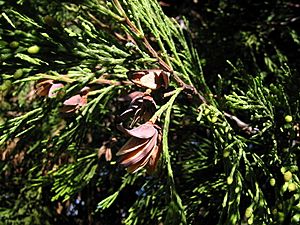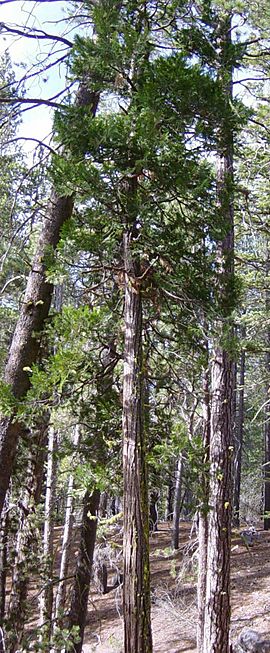Incense cedar facts for kids
Quick facts for kids Incense-cedar |
|
|---|---|
 |
|
| Calocedrus decurrens California incense cedar |
|
| Scientific classification |
|
| Kingdom: | Plantae |
| Clade: | Tracheophytes |
| Division: | Pinophyta |
| Class: | Pinopsida |
| Order: | Pinales |
| Family: | Cupressaceae |
| Subfamily: | Cupressoideae |
| Genus: | Calocedrus Kurz |
| Type species | |
| Calocedrus macrolepis |
|
| Synonyms | |
|
Heyderia K.Koch, illegitimate homonym |
|

Calocedrus, also known as incense cedar, is a type of evergreen tree. These trees are called conifers and belong to the cypress family, Cupressaceae. Scientists first described this group of trees in 1873. You can find incense cedars growing naturally in eastern Asia and western North America. The name Calocedrus means "beautiful cedar," which fits these lovely trees!
Contents
What Are Incense Cedars?
Incense cedars are related to another tree group called Thuja. Both have small, flat leaves that overlap like scales. However, incense cedars are special because their leaves appear in groups of four. Their cones also have only 2 or 3 pairs of thin, upright scales. This is different from Thuja cones, which have more scales.
Types of Incense Cedars
There are different kinds of incense cedars. Some are still alive today, and some are only known from fossils.
Living Species
| Image | Name | What It's Like | Where It Grows |
|---|---|---|---|
 |
Calocedrus decurrens, California incense cedar | This is a very large tree. It often grows 40–60 meters (about 130–200 feet) tall. Its trunk can be up to 3 meters (10 feet) wide. It has a wide, cone-shaped top with spreading branches. Its leaves are bright green on both sides. The cones are 2–2.5 cm long. This is the most famous type of incense cedar. | Western North America |
 |
Calocedrus formosana, Taiwan incense cedar | This tree is very similar to C. macrolepis. Some experts even think it's a type of C. macrolepis. It's a medium-sized tree, growing 25–30 meters (about 80–100 feet) tall. It is rare in nature, found only as single trees in mixed forests. Its leaves are a blue-green color on top. They have bright white marks on the underside. The cones are 1.5–2 cm long and grow on a 1–1.5 cm stem. | Taiwan |
 |
Calocedrus macrolepis, Chinese incense cedar | This is also a medium-sized tree, reaching 25–30 meters (about 80–100 feet) tall. Like C. formosana, it is rare in the wild. Its leaves and cones look much like C. formosana. The main difference is its shorter cone stem, which is only about 0.5 cm long. | Southwest China (from Guangdong to Yunnan), northern Vietnam, northern Laos, northern Thailand, and northeastern Myanmar |
| Calocedrus rupestris | This is the newest living species of Calocedrus. It was first found and described in 2004. It grows only on rocky limestone areas, which are called karst terrain. This type of habitat often has unique plants. Because it grows near the Chinese and Laotian borders, it might also be found in those countries. It's an evergreen tree up to 25 meters (80 feet) tall. It has a broad, rounded top. The name "rupestris" means "rock-dwelling." | Vietnam |
Extinct Species
These types of incense cedars are no longer alive today. We know about them from fossils.
| Name | What It's Like | Where It Was Found |
|---|---|---|
| †Calocedrus huashanensis | This species was described in 2012. We know about it from compression fossils. These fossils were found in rocks from the Oligocene age in southern China. Calocedrus huashanensis fossils include branches and leaves. | Southern China |
| †Calocedrus suleticensis | This species is known from fossils of a cone. These fossils were found in rocks from the Early Oligocene period. They were discovered in Probostov, Bohemia, in a volcanic area. | Bohemia |
How People Use Incense Cedars
Incense cedars have been useful to people for many things throughout history.
Bows and Arrows
Native Americans in California often used incense cedar wood to make bows. This wood is very flexible and strong for its weight. It was a favorite material, along with Juniper and Pacific Yew. When a bow made from incense cedar was strengthened with animal sinew, it became very powerful. These bows could shoot arrows with great speed and force. They were almost as good as bows made from horn and sinew. The archer Saxton Pope saw that Ishi, a famous Native American, used this wood for his short bows.
Lumber and Wood Products
The wood from incense cedars is soft and smells spicy and resin-like. It also resists decay quite well. The wood from C. decurrens is mainly used to make wooden pencils. This is because it is soft and sharpens easily without breaking into splinters. In the past, the two Asian species were highly valued in China for making coffins. People liked the wood's scent and its ability to resist decay. It's thought that too much harvesting in the past is why these trees are rare today.
Native Peoples of Northern California also used incense cedar wood. They preferred it for the bottom board of a bow drill. This tool helped them start fires by rubbing wood together.
Growing Incense Cedars
Calocedrus decurrens, the California incense cedar, is a popular ornamental tree. People like to grow it in places with cool summers, such as Britain, Washington, and British Columbia. In these areas, the tree often grows a very narrow, column-like top. This is different from how it looks in its natural habitat. Scientists are not sure why this happens. The California incense cedar is also good for places with drought because it can handle dry conditions. The Asian species are not grown as often.
Images for kids
See also
 In Spanish: Calocedrus para niños
In Spanish: Calocedrus para niños



